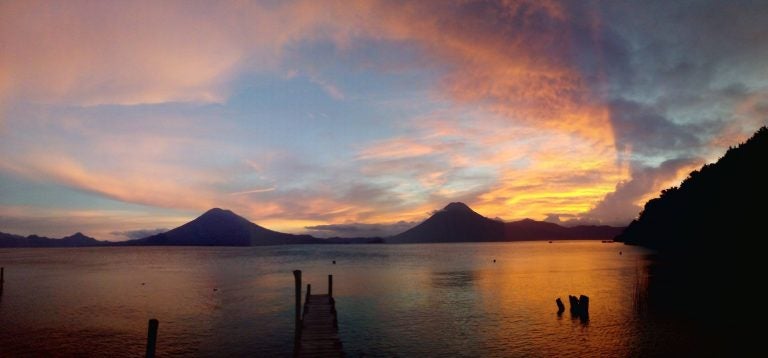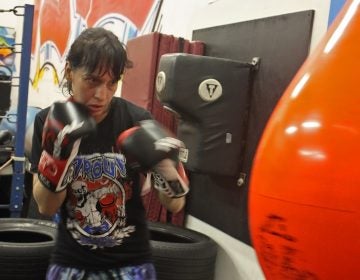An elegy for Stephen Hawking and the worthy pursuit of wonder

Sunset over Lago de Atitlán in Guatemala. (Image courtesy of Michael Tallon)
A few months ago, I went paragliding with my friend Christian above Lago de Atitlán in Guatemala. He was the pilot, I was his awkward and somewhat oversized passenger. Christian said that, normally, when the wind is right, after both members of the pair are secured into the harness for tandem flight, he just flips the parachute-like wing up above his head, and all 400 pounds of normally earthbound Homo sapiens float up and into the sky.
For us, however, the wind was weak, so we had to make a run for the cliff.
Literally one step from the edge, I felt the ground fall away as we gained lift, then, once over the edge and out of a column of relatively warmer air, we fell, disturbingly quickly, toward a line of trees growing at an angle from the side of the mountain. Yet, as Christian knew it would, because he understood the physics, the speed of our gravitational acceleration created a favorable laminar air flow over the wing which arced us up and away from what I thought would be a bloody mess, a long dangle, and then a trip to the hospital (or the morgue) for us both.
Having escaped that fate, Christian read the air, the terrain below, the wind moving across the face of the lake, and steered us toward rising thermals until we’d climbed 700 meters above the land and water below. What followed was one of the most peaceful and beautiful hours of my entire life.
Listening to the wind and scanning the horizon toward the three magnificent volcanoes that form the lake’s southwestern wall, I felt a profound connectedness to the forces that create the blueness of the sky, the thin fabric of the clouds, the geothermal forces that shape the land. When flying, as a passenger at least, there simply is nothing else to do but observe and to think, and observation from any new perspective causes wonder. It’s the way of the mind.
As I considered the oddness of my situation — a human being supported in the middle of the sky by some Kevlar strings and a few pounds of nylon — I was struck by just how safe I felt, and I noted that it had something to do with the way I was sitting.
Once situated in the harness, I sat with my bottom very low and my legs bent sharply at the knees, but they were taking no weight. Also, they rested together and leaned off to the right. My torso was leaning in the opposite direction. My arms were folded awkwardly in my lap, and I suddenly realized that I knew this body position from one place in particular. I was seated like Stephen Hawking in his wheelchair, and I too was silently observing a gloriously beautiful world that was spread out like a canvas all around, and yet unable to be touched directly. I marveled at that quick and passing insight into how the good professor might perceive the world. Perhaps it was just imagined, or perhaps that is the exact reason we have this thing called an imagination, but I felt a brotherhood bloom with Stephen.
I also hatched a plan. As soon as I completed the project that brought me to Lago de Atitlán in the first place, I was going to write Stephen Hawking a letter. After I did that, I was going to find a way to get it to him, and I was going to propose making a documentary film called “Flying with Hawking,” in which we’d tell the whole story from this very moment, through the meeting of Dr. Hawking at Cambridge, to the initial conversations about the physics of flight, to the logistics of bringing him to Guatemala and the beautiful final scenes of strapping him into harness with my friend Christian on a day when the wind was just right so that they’d float up into the sky without having to run toward the edge.
Back on the ground, I told Christian about the plan, and he loved it. Of course he’d fly the world’s smartest man over the Earth’s most beautiful lake!
Now all I needed was a filmmaker and 10 or 20 thousand dollars, but those details, I was sure, could be addressed. It was a perfect idea. I even had the ending. I imagined a final scene with Hawking doing a voiceover in his unmistakable, mechanical, and yet deeply comforting voice as he described the forces behind the cosmic dance that gave our planet an atmosphere, a biosphere, that was both miraculous and navigable at the same time. Because that, to me — and I think to him, too — is the whole damn point: Our planet, our solar system, our universe is a knowable, infinitely discoverable, relentlessly complex miracle, and we get to fly through it in mid-wonder.
I saw the movie ending with a single camera pointed at his beautiful face, with the land and water below, as his eyes took in the blue sky and the clouds above while Van Morrison sang “Into the Mystic” in the background. Overwrought as that might be, it’s an image I’ll cherish even if it never quite occurred in this quantum universe.
As I mourn the death of Dr. Hawking, I will note that just Wednesday, as I crossed the lake from Paxanax to Panajachel, I looked up at the cliffs above Santa Catarina Palopó and I saw three paragliders in flight and resolved to move forward with this project. He’s not gonna last forever, I thought.
And so, perhaps as the great man was passing, some of his information escaped the event horizon of his own finality. Who knows, maybe there’s something in there about entangled particles and the eternal mysteries of awareness? At the very least, it’s worth wondering about.
Everything is worth wondering about.
Safe journey, my beautiful brother. See you round the bend.
—
Michael Tallon is a writer and magazine publisher from upstate New York, currently living and working in Antigua, Guatemala.
WHYY is your source for fact-based, in-depth journalism and information. As a nonprofit organization, we rely on financial support from readers like you. Please give today.




